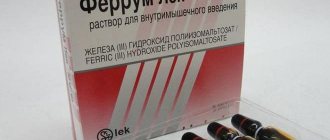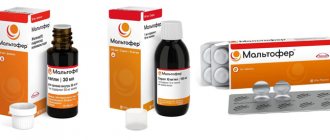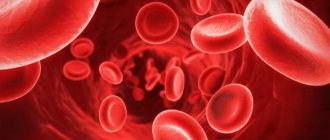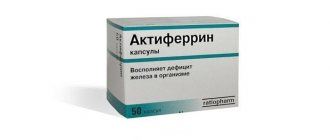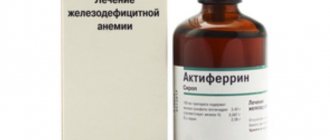Pharmacological properties of the drug Ferrum lek
Iron supplement. Contains iron Fe3+ in the form of a complex compound of iron (III) hydroxide with polymaltose (HPA). The iron in the polynuclear "core" is associated with a structure similar to serum ferritin. This macromolecular complex is stable and under physiological conditions does not release iron in the form of free ions. Therefore, when taken orally, iron, which is part of the GPC, enters the blood from the intestine only through active absorption. There is a correlation between the degree of iron deficiency and the amount of iron absorbed (the higher the iron deficiency, the better the absorption). It is this property of the drug that explains the impossibility of poisoning with the drug even in the case of an overdose, unlike simple iron salts, the absorption of which occurs along a concentration gradient. Maximum absorption of iron after oral administration occurs in the duodenum and jejunum, and its absorption is not reduced by interaction with certain food components or with drugs containing a phenolic group (for example, tetracycline). Iron administered in the form of HPA is slowly absorbed and enters the blood serum, from where it quickly passes into iron-depositing tissues. Absorbed iron is stored bound to ferritin, mainly in the liver. Later in the bone marrow it is included in hemoglobin. In hemoglobin, iron is in divalent form, but it is Fe3+ (trivalent iron) that stimulates the formation of globin, which ultimately helps to increase hemoglobin levels. Since iron in the dosage form for oral administration is contained in non-ionized form, the drug does not have such side effects as irritation of the mucous membrane of the digestive tract, staining of tooth enamel, and the appearance of a metallic taste in the mouth. Chewable tablets and syrup are characterized by a high degree of safety and are well tolerated by patients. Comparative studies of the bioavailability of Ferrum Lek oral dosage forms using the radioisotope method, as well as comparative clinical trials, have proven that the absorption and bioavailability of iron in the form of iron (III) hydroxide complex with polyisomaltose is equivalent to the absorption and bioavailability of iron (II) salts.
Analogs
The main analogues are “Sorbifer” and “Maltofer”. Let's compare them:
- “Maltofer” and “Ferrum Lek” contain similar contents of the active ingredient, so the therapeutic effect of their use will be virtually the same. Both drugs are produced by serious pharmaceutical companies with a good reputation, so the choice depends solely on the individual preferences of the attending physician and the tolerability of one form or another. Maltofer, however, is able to offer more forms for oral administration, which are supplemented with drops and solution. This allows you to select the optimal dosage of the drug in each specific situation. In the case of Ferrum Lek, this option is excluded, since the tablets and syrup contain the same amount of iron - 100 mg. If the patient requires a smaller dosage, then it makes sense to give preference to Maltofer drops. Thus, if we consider drugs from the point of view of convenience, then Maltofer certainly wins.
- "Sorbifer" and "Ferrum Lek". Many patients claim that Sorbifer is less tolerated by the body and more often causes irritation of the gastric mucosa and constipation. However, this is most likely due to an individual reaction to the components of the drug. If such signs appear, it is better to switch to another drug and select until the most optimal option is found. The composition of the drugs is somewhat different: “Sorbifer” is produced on the basis of ferrous sulfate, and “Ferrum Lek” is made from polymaltosate hydroxide. Both substances are well accepted by the body and do not cause an overdose of iron. However, the active ingredient Ferrum Lek is similar in composition to what is found in the body, therefore the absorption of the drug is more successful. “Sorbifer,” in turn, has the ability to slowly release iron, so it is preferable for people with a tendency to nausea.
Indications for use of the drug Ferrum lek
Orally prescribed for the prevention and treatment of iron deficiency conditions of various etiologies, including the prevention of iron deficiency in children, women of childbearing age (especially during pregnancy and breastfeeding), adults (especially vegetarians) and the elderly; treatment of iron deficiency anemia. Ferrum Lek for parenteral administration is indicated for the treatment of iron deficiency conditions that require rapid and reliable compensation of iron deficiency: severe posthemorrhagic anemia, impaired iron absorption, as well as when treatment of iron deficiency anemia with oral iron preparations is ineffective. Ferrum Lek is used in patients with clear indications for the drug, with mandatory determination of the level of ferritin in the blood plasma and the number of red blood cells in the peripheral blood. If iron malabsorption is suspected, an iron absorption test should be performed.
Use of the drug Ferrum lek
The dose and duration of taking the drug depend on the severity of iron deficiency. Tablets and syrup for the treatment of iron deficiency conditions are prescribed in the usual daily dose: adults and children over 12 years of age in the absence of clinical signs of anemia - 10 ml of syrup or 1 tablet per day, in the presence of clinical signs of anemia - 30 ml of syrup per day or 1 tablet 3 times a day; children aged 1–12 years - at the rate of 3 mg of iron per 1 kg of body weight per day or 5–10 ml of syrup per day; it is recommended that syrup be prescribed to infants in an initial dose of 10 drops per day, gradually increasing the dose to 5 ml (1 teaspoon of syrup) per day. A teaspoon of syrup contains 100 drops. Women during pregnancy or breastfeeding are prescribed 20–30 ml of syrup or 1–3 tablets per day.
Patients | Treatment of iron deficiency | Prevention of iron deficiency | ||
Pills | Syrup | Pills | Syrup | |
| Children under 1 year of age | 2.5–5 ml/day | — | — | |
| Children aged 1–12 years | 5–10 ml/day | — | — | |
| Adults and children over 12 years old | 1–3 tablets per day | 10–30 ml/day | — | — |
| Women during pregnancy and breastfeeding | 1–3 tablets per day | 20–30 ml/day | 1 tablet per day | 5–10 ml/day |
The duration of use of chewable tablets or Ferrum Lek syrup is at least 3 months after normalization of the peripheral blood composition to restore the iron depot in the body (course of treatment is 6 months). To prevent iron deficiency conditions, the usual dose for pregnant and breastfeeding women is 5–10 ml of syrup or 1 tablet per day. Solution for IM administration IV administration of the solution is contraindicated! Before administering the first therapeutic dose of the drug, its tolerability is determined by administering a test dose - 1/4–1/2 from an ampoule of Ferrum Lek (which corresponds to 25–50 mg of iron) for adults and half the daily dose for children. If no undesirable effects develop over the next 15 minutes, administer the remainder of the initial daily dose. 1 ) first, calculate the total iron deficiency (TID) (mg): TID = TI + ID, where TI is iron included in hemoglobin, mg: TI is = MT (CZG - AIG) 0.24, where MT body weight (kg); CZH - target hemoglobin value, g/l (for body weight up to 35 kg - 130 g/l, for body weight more than 35 kg - 150 g/l); AUC —actual hemoglobin level, g/l; coefficient 0.24 = 0.0034 • 0.07 • 1000, where 0.34% is the iron content in hemoglobin; 7% - total blood volume as a percentage of body weight; 1000 is the conversion factor from grams to milligrams; ID - deposited iron, mg (for body weight up to 35 kg - 15 mg per 1 kg of body weight, for body weight more than 35 kg - 500 mg); 2) calculate the total number of ampoules per course of treatment (OCA): OKA = OCA: 100, where 100 is the iron content in 1 ampoule, mg. Calculation example: body weight = 70 kg; actual hemoglobin level = 80 g/l; iron included in hemoglobin - 70 • 0.24 • (150 – 80) = 1200 mg of iron; deposited iron - 500 mg of iron; general iron deficiency - 1200 + 500 = 1700 mg of iron; the total number of ampoules per course of treatment is 1700: 100 = 17. Table for calculating the total number of ampoules for one patient per course of treatment.
Body weight, kg | Total number of Ferrum Lek ampoules per course of treatment | |||
Hb = 60 g/l | Hb = 75 g/l | Hb = 90 g/l | Hb =150 g/l | |
| 5 | 1,5 | 1,5 | 1,5 | 1,0 |
| 10 | 3,0 | 3,0 | 2,5 | 2,0 |
| 15 | 5,0 | 4,5 | 3,5 | 3,0 |
| 20 | 6,5 | 5,5 | 5,0 | 4,0 |
| 25 | 8,0 | 7,0 | 6,0 | 5,5 |
| 30 | 9,5 | 8,5 | 7,5 | 6,5 |
| 35 | 12,5 | 11,5 | 10,0 | 9,0 |
| 40 | 13,5 | 12,0 | 11,0 | 9,5 |
| 45 | 15,0 | 13,0 | 11,5 | 10,0 |
| 50 | 16,0 | 14,0 | 12,0 | 10,5 |
| 55 | 17,0 | 15,0 | 13,0 | 11,0 |
| 60 | 18,0 | 16,0 | 13,5 | 11,5 |
| 65 | 19,0 | 16,5 | 14,5 | 12,0 |
| 70 | 20,0 | 17,5 | 15,0 | 12,5 |
| 75 | 21,0 | 18,5 | 16,0 | 13,0 |
| 80 | 22,5 | 19,5 | 16,5 | 13,5 |
| 85 | 23,5 | 20,5 | 17,0 | 14,0 |
| 90 | 24,5 | 21,5 | 18,0 | 14,5 |
If the total number of Ferrum Lek ampoules exceeds the maximum daily dose, it is necessary to divide the administration of the drug into several doses. If after 1–2 weeks of therapy there is no normalization of blood counts, it is necessary to reconsider the established diagnosis. Calculation of the total dose of Ferrum Lek for intramuscular injection to replenish iron losses due to blood loss. The required number of ampoules is calculated using the following formulas:
- If the amount of blood lost is known, the administration of 200 mg of iron IM (2 ampoules) causes an increase in hemoglobin levels by 1 unit of blood (400 ml 150 g/l hemoglobin content). Required amount of iron (mg) = number of blood units lost • 200 or required number of Ferrum Lek ampoules = number of blood units lost • 2.
- If a reduced hemoglobin level is known , use the formula for calculation, assuming that there is no need to replenish stored iron: required amount of iron (mg) = body weight (kg) • (target hemoglobin value [g/l] - actual hemoglobin level [g/l ]) • 0.24. For patients weighing 60 kg with a hemoglobin deficiency of 10 g/l, the required amount of iron is 150 mg or 1.5 ampoules of Ferrum Lek.
The usual dose of Ferrum Lek for intramuscular administration : Children: 0.6 ml of the drug per 1 kg of body weight per day (3 mg of iron per 1 kg of body weight per day). Adults and elderly patients: contents of 1-2 ampoules of Ferrum Lek (100-200 mg iron) depending on the hemoglobin level. Maximum daily dose of Ferrum Lek for intramuscular administration Children: 0.14 ml of the drug per 1 kg of body weight per day (7 mg of iron per 1 kg of body weight per day). Adults: 4 ml of the drug (contents of 2 ampoules) Ferrum Lek. Ferrum Lek for intramuscular injection is administered every other day, deep intramuscularly, alternately into the left and right gluteal muscles. Before use, carefully check the ampoule visually. It is allowed to use only a transparent solution that does not contain sediment. If sediment appears and after the expiration date indicated on the package, the ampoule is not suitable for use. The ampoule is opened immediately before injection. The IM injection is performed slowly to avoid pain and staining of the skin, into the upper outer quadrant of the buttock with a needle 5–6 cm long. Before the injection, wipe the skin with alcohol, pull it to the side by 2 cm so that after removing the needle the injection channel is covered with skin to prevent fluid from leaking into the subcutaneous fat. During injection, the pulled skin is gradually released; after the injection, the injection site is pressed for 1 minute.
Contraindications to the use of the drug Ferrum lek
Hypersensitivity to the drug , anemia not caused by iron deficiency, including hemolytic; hypersensitivity to any of the components of the drug; excess iron in the body (hemochromatosis, hemosiderosis); disorders of hemoglobin synthesis (anemia caused by lead poisoning, sideroblastic anemia), thalassemia; severe hemostasis disorders (hemophilia); oral administration is not advisable when there is a decrease in the concentration of iron in the blood serum and anemia caused by a chronic inflammatory process or neoplasm.
When not to use
Contraindications for the use of Ferrum Leka of any dosage form are:
- anemia not associated with iron deficiency;
- allergies to the components of the product;
- inflammatory processes of the gastrointestinal mucosa (gastritis, enterocolitis, Crohn's disease).
Before starting treatment with this drug, it is necessary to do tests of the kidneys, thyroid gland, and liver. The presence of hepatitis, cirrhosis, hyperthyroidism, and acute infectious kidney diseases in the patient does not allow the use of this medicine.
Side effects of Ferrum Lek
Usually well tolerated, side effects are mostly transient and mild. Gastrointestinal disorders such as a feeling of heaviness and fullness in the stomach, distension in the epigastric region, nausea, constipation or diarrhea are very rarely observed. Dark coloration of stool caused by iron supplementation is not clinically significant. With intramuscular administration, arterial hypotension, arthralgia, swollen lymph nodes, fever, headache, dizziness, and infiltrate at the injection site rarely occur; very rarely - anaphylactic and anaphylactoid reactions.
Adverse reactions
The drug in the form of syrup and tablets can cause the development of the following conditions:
- Feeling of fullness and heaviness in the stomach.
- Constipation.
- Nausea.
- Diarrhea.
- The feces turn black.
When administering the Ferrum Lek solution, according to patient reviews, in addition to the symptoms listed above, the following may also develop:
- Dizziness.
- Vomit.
- Decreased blood pressure.
- Joint pain.
- Enlarged lymph nodes.
- Headache.
- Temperature increase.
- Allergy.
- A state of general malaise.
- Darkening of the skin and painful lumps may be observed at the injection site.
According to reviews, the instructions for Ferrum Lek are very detailed. The manifestation of side effects from the use of the drug does not require special treatment. As a rule, symptoms go away on their own some time after stopping the medication.
Special instructions for the use of the drug Ferrum Lek
1 tablet contains 0.04 XE, 1 ml of syrup - 0.04 XE. Each Ferrum Lek tablet contains 1.5 mg of aspartame (a precursor to phenylalanine), and may therefore have an adverse effect on patients with phenylketonuria. In controlled trials, the use of the drug in the second and third trimester of pregnancy did not have a negative effect on the fetus. Iron is released into breast milk in the form of a complex with lactoferrin, only a small amount of iron from the complex of iron (III) hydroxide with polymaltose passes into breast milk in ionized form, so the occurrence of side effects in an infant when the mother takes Ferrum Lek is unlikely. Parenteral administration of iron preparations can cause the development of allergic reactions. For an allergic reaction of moderate severity, the administration of antihistamines is recommended. If an anaphylactic reaction develops, immediate administration of epinephrine is indicated. The risk of developing anaphylaxis is quite high in patients with asthma, Crohn's disease, polyarthritis, reduced iron binding capacity and/or folic acid deficiency.
Compound
Unlike many other drugs, this one comes in several completely different forms:
- Syrup in glass bottles of 100 ml.
- Chewable tablets in packs of 30 or 50 pieces.
- Solutions for intramuscular administration in ampoules of 2 ml.
- Solution for intramuscular administration in ampoules of 5 ml.
The composition of the drug is actually one-component and includes iron in doses necessary for the normal functioning of the body. The drug in the form of syrup and tablets "Ferrum Lek", according to patient reviews, is often used.
Interactions of the drug Ferrum lek
Do not mix the solution for intramuscular administration with other medications; Like other iron preparations for parenteral use, Ferrum Lek is not prescribed simultaneously with iron preparations for oral administration. The interval between parenteral use of the drug and the start of use of oral dosage forms of iron should be at least 5 days. Since iron is included in the drug in the form of a complex of iron (III) hydroxide with polymaltose, when taken in the form of chewable tablets or syrup, it does not form insoluble chelate compounds with components of food products (phytin, oxalates, tannin) or medicines (tetracyclines, antacids ).
Ferrum lek overdose, symptoms and treatment
With parenteral administration, hemosiderosis may develop. Incorrect diagnosis of anemia as iron deficiency can lead to iron overdose. In case of an overdose of tablets or syrup, symptoms of acute poisoning can develop in extremely rare cases, since iron from HPA is absorbed not through passive diffusion, but through active transport, and the degree of absorption of iron from HPA directly depends on the severity of iron deficiency. Treatment is symptomatic; a specific iron antidote is the chelating agent deferoxamine.
Side effects
As for side effects, Ferrum Leka drugs rarely cause them, but they still exist, and they should be given due attention. While taking the drug, you may experience:
- heaviness, pain in the stomach;
- dyspeptic disorders;
- inflammation of the gastrointestinal mucosa;
- allergies;
- general malaise;
- fever.
When taking oral medications, the stool turns black. Injection administration of Ferrum Leka can lead to compaction at the injection site and pain.
